|
Click Here to return to Boston Illustrated Content Page Click Here to return to Previous Chapter |
 (HOME) |
|
Click Here to return to Boston Illustrated Content Page Click Here to return to Previous Chapter |
 (HOME) |
|
VII. NEW BOSTON AND THE SUBURBS.
WE have already said that Boston has grown in territorial extent not only by robbing the sea, but by absorbing other outlying tracts of land and whole municipalities. The first addition of the latter kind was made in 1637, when Noddle’s Island was “layd to Boston,” and its name changed to East Boston. It was practically uninhabited, however, until 1833, when a company of capitalists bought the entire island and laid it out for improvement. Its growth since that time has been rapid, but it is still capable of great increase in population, as well an in wealth and business. A part of South Boston was taken from Dorchester in 1804 by the Legislature, much against the will of the people of that town, and annexed to Boston. Again, in 1855, the General Court added to the territory of the city by giving to it that part of South Boston known as Washington Village. However, Boston has now made peace with Dorchester by taking to itself all that remained of that ancient town. Roxbury, which had a history of its own, and a name which many of the citizens were exceedingly loath to part with, became a part of Boston on the 6th of January, 1868. It was incorporated as a town but a few days after Boston, it was the home of many distinguished men in the annals of Massachusetts and the country, and it took a glorious part in the several struggles in which the Colonies and the Union were engaged. In the old times, when that narrow neck of land to which we have repeatedly alluded in the previous pages, was the only connection between Boston and Roxbury, there were good reasons why the two should be under separate governments; but long ago the two cities had met, and joined each other. Dorchester was incorporated the same day as Boston. It too had its history, and but for the manifest advantages to both municipalities of a union, might have retained its separate existence. The act of union, passed by the Legislature in June, 1869, was accepted by the voters of both places the same month, and the union was consummated on the 3d of January, 1870. The Legislature of 1873 passed separate acts annexing Charlestown, West Roxbury, Brookline, and Brighton, to Boston, each case being made independent of the others and dependent upon the consent of the parties to the union. Only Brookline uttered a “nay” to the wooer, and the other three became parts of Boston at the beginning of 1874. It is with a few among the many objects of interest in these outlying parts of Boston, and in the suburbs, that we shall have to do in this chapter. One of the most interesting of the public institutions in the city is the Perkins Institution and Massachusetts Asylum for the Blind, at South Boston. It has been more than fifty years in operation with uninterrupted and most remarkable success. It was instituted in 1831. In the following year, Dr. Samuel G. Howe undertook its organization; and began operations with six blind children as the nucleus of a school. For a year the institution was greatly hampered by a lack of funds; but a promise of an annual grant by the Legislature, a generous sum raised by a ladies’ fair, and liberal contributions by the people of Boston, speedily settled the financial question and opened a period of prosperity a n d usefulness which has continued to the present time. Wonders have been accomplished in the institution in the instruction of unfortunate youth deprived of sight; and in some cases, notably that of Laura Bridgman the absence of the sense of hearing also has not been an insuperable obstacle to learning. This asylum was under the direction of Dr. Howe, its founder, until his death in 1877, and a great deal of the success of the experiment is to be credited to his peculiar fitness for the position, and to his devotion to its interests. His son-in-law, Mr. Michael Anagnos, is at present at the head of the institution as Superintendent. The main building is situated on high ground on Mount Washington. Of late years the plan of the institution has been changed. The sexes are entirely separated, the women occupying dwelling-houses built for the purpose. ‘The in-mates, of both sexes, are divided into families, each of which keeps a separate account of its expenses. The Asylum is partly self-supporting, such of the pupils as are able to pay maintaining themselves as at a boarding-school, and all the pupils being taught some useful trade. Several States, particularly the New England States, pay for the support of a large number of beneficiaries. 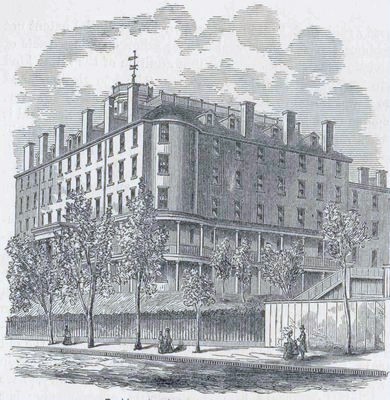 Perkins Institution for the Blind. In East Boston are the extensive terminal improvements of the Boston and Albany railroad made since the purchase by the company of the Grand Junction railroad and wharf. The railroad forms a connection between the main line of the Boston and Albany, and the Fitchburg, Lowell, Eastern, and Boston and Maine railroads, and gives the Albany road a deep-water connection. Wheat-trains from the West are here emptied of their contents by machinery directly into an elevator which has a capacity of a million bushels, from which in turn vessels may be rapidly loaded. Ample facilities are afforded for loading and unloading the Cunard and other lines of steamships; while the facilities for the reception and dispatch of immigrants here are unequalled by those of any other city on the continent. Immigrants - who are to continue their journey by land into other States are provided with every comfort, and are completely secluded from sharpers, who are always on the look-out for an opportunity to swindle, until they are sent away in trains over the Grand Junction and the Boston and Albany roads without being compelled even to pass through the city. The amount of business transacted at this wharf is immense. The railroad and wharves were built in 1850— 51, and on the occasion of their opening a three days’ jubilee was held in Boston, in which many notables, the President of the United States among them, participated. But the enterprise did not pay. And when the present owners came into possession of the property in 1868, no train had been run over the road in fourteen years. Vast improvements have been made since then.  Grand Junction Wharves, East Boston. Eliot Square, into which Dudley, Roxbury, and Highland Streets converge, is a small park in the Roxbury district, which possesses several points of interest. Here stands the old Unitarian meeting-house of the first church in Roxbury, taking rank in age next after the first church in Boston. Over this church the Rev. Dr. George Putnam was settled as pastor for over forty years. The dwelling-houses in this square are many of them old, this part of the Roxbury district having been settled long before the over-crowded streets of Boston sent thousands of the citizens to seek sites for modern villas on the more picturesque hillsides of this and other suburban districts of the city and towns. On this square, too, stands the Norfolk House, a fine building externally, and a favorite boarding-hotel. 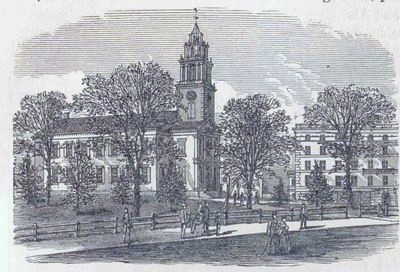 First Church in Roxbury, and the Norfolk House. One of the most important improvements in the Cochituate Water-Works was made in 1869, when the stand-pipe in the Roxbury district was erected and put in use. By this simple expedient, which has been found to work admirably in practice, the “head” of water is increased over the whole city so greatly that the water is forced to the highest levels occupied by dwelling-houses. The stand-pipe is on the “ Old Fort” lot in Roxbury, between Beech-Glen Avenue and Fort Avenue. 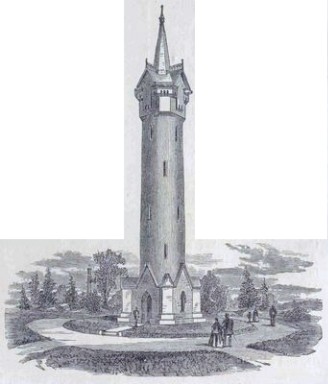 Stand-Pipe of Cochituate Water—Works. The base of the shaft is 158 feet above tide marsh level. The interior pipe is a cylinder of boiler iron, eighty feet long; and around this pipe, but within the exterior wall of brick, is a winding staircase leading to a lookout at the top. The total cost of the structure and the pumping-works connected with it was about $100,000. It was intended to supply high service to those parts of the city which were at the higher levels, but it was found adequate to the supply of the whole city; thus it superseded the old reservoir on Beacon Hill, and has itself been rendered useless by the new Parker Hill reservoir. The Roxbury district always had a good reputation for remembering its great men. We have still in this district Dudley, Eustis, and Warren Streets, and numerous others named in memory of distinguished citizens. General Joseph Warren has been especially remembered, for besides the street which bears his name, there is a steam fire-engine called after him, and the dwelling-house that stands on the spot where his house stood, bears a tablet commemorating the fact. The house stands in a charming site behind a row of fine old trees. The Dorchester district was a delightful old town, and is a charming new district of the city. It retains many of its ancient characteristics, and some of its quaint old houses are still preserved. Since its annexation to the city it has been rapidly built up, and it is now a district of pleasant rural homes and charming country houses, with many of the conveniences and comforts of the city. Its picturesque hills and fine old woods have made it a favorite place for the erection of elegant residences. On many of these estates large sums of money have been lavished, and the skill of the architect and the art of the landscape-gardener invoked to render them as attractive as possible. By such means the scenery of Dorchester has been made exceedingly rich and varied. Here a road passes through the midst of large and finely-kept estates, surrounding handsome dwelling-houses, to plunge into a wilderness, where the fields are barren and rocky, and the forests in all their primitive wildness. Again we come upon a thriving village, and pass out of it to find new beauties by the seaside. We give two views of Dorchester scenery, the one showing Meeting-House Hill, which is one of the landmarks in Dorchester, and the other Savin Hill, as seen from Dorchester Point, — the first belonging to the older part of Dorchester, the latter more modern as a place of residence. 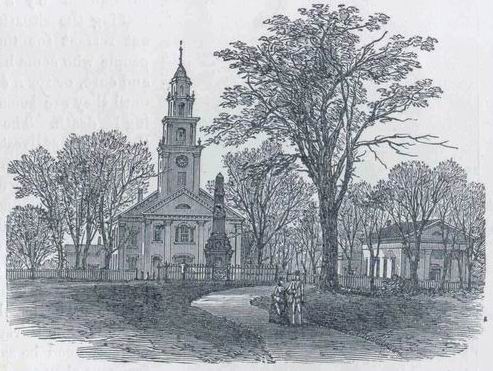 Meeting-House Hill. The estate known as Grove Hall, at the junction of Warren Street and Blue Hill Avenue, in the Dorchester district, was purchased for the Consumptives’ Home a few years ago, and is now occupied by that and its attendant institutions. It is a large and spacious mansion, and is surrounded by ample grounds, making the situation a most pleasant retreat for the poor, diseased people who come here for treatment and cure, or for a comfortable home until they are released from suffering by death. The system of which the Consumptives’ Home is supported is the same as that upon which the famous orphan asylum of Mailer is maintained. The founder was Dr. Charles Culls. He calls his institution a “Work of Faith” because he says he depends entirely upon prayer for contributions to sustain it. The usual number of patients is from thirty-five to fifty; it scarcely need be said that there are frequent changes, owing to the hopeless nature of the disease. The plan of the institution is to admit all poor persons sick with consumption, and without home or friends to relieve them, old or young, black or white, native or foreign. 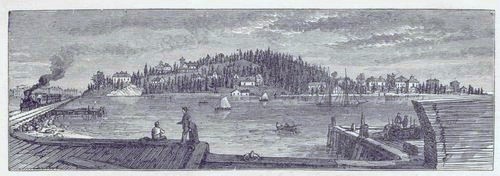 Savin Hill, from Old Colony Railroad. |